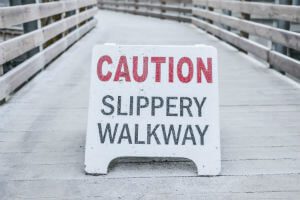 Slip and fall accidents are far too common, especially during winter in Ontario. Because these accidents can lead to serious injuries, it is important to know what to do after a slip and fall accident to help protect yourself and your legal right to compensation for your injuries.
Slip and fall accidents are far too common, especially during winter in Ontario. Because these accidents can lead to serious injuries, it is important to know what to do after a slip and fall accident to help protect yourself and your legal right to compensation for your injuries.
If you believe your injury was caused by the property owner’s negligence, you may have a legal case for holding the owner liable for your injuries. Contact the experienced Windsor slip and fall accident lawyers at Greg Monforton & Partners to learn more about your options.
After an accident, you should:
1. Seek Medical Attention Immediately
A slip and fall accident could cause serious injuries that may not be obvious at the time. Sometimes, it takes a few hours or even days before you feel the full extent of your injuries.
Even if you are not in any pain or do not have any obvious injuries, it is important to seek medical treatment as soon as possible. The longer you wait, the worse your injuries could be.
Failing to seek medical treatment on time could also work against you when you try to claim compensation. Your medical records will link to the accident, which will be important for building your claim.
2. File an Accident Report
It is important to file an accident report any time you are involved in a slip and fall accident. The accident report tells the owner of the property where you were injured and what happened.
If your accident happened at a business, the company may have a specific form for you to fill out. If there is no form available, simply write down the information on a piece of paper. Be sure to keep a copy of the accident report yourself, as it will be important for your claim.
3. Document the Accident with Photos
From the time you fall, you need to be aware of what is happening around you and document it. This can sometimes be difficult, especially if you are hurt, but it could be essential for claiming compensation.
Take photos of the area where you fell, what caused the accident, your injuries and even the people around you. Document the conditions of the area where the accident occurred, including:
- Wet floors
- Lack of signs or warnings
- Food on the floor
- Spills
- Uneven pavement
- Broken sidewalks
- Torn carpet
- Wrinkled rugs
- Electric wire
- Products on the floor
- Debris
- Tools or equipment
It’s not always easy to notice what caused your accident, so it is important to document the entire scene.
4. Avoid Giving a Statement to the Insurer
When you are injured on someone else’s property, you will need to file a claim with their insurance company.
If the insurer asks you to write or give a verbal statement about the accident, you have the right to refuse until you have spoken with your lawyer. When you give a statement to the insurer, it is considered to be an accurate description of the accident and will be used to determine if and how much compensation you can recover.
The insurer will use everything it can to try to avoid paying you, so you need to be very careful about what you say. If you are going to give a statement, it is best to do so after speaking with your lawyer. He or she will work with you to prepare a statement or might even give the statement to the insurer. Do not talk about the accident with anyone other than your lawyer.
5. Contact a Slip and Fall Accident Lawyer
Having an experienced lawyer by your side after a slip and fall accident can be a vital resource for recovering the compensation you need to recover from your injuries. Our team can handle all details of your claim for you, including investigating the accident, gathering evidence, building your claim and negotiating with the insurance company on your behalf.
Contact Greg Monforton & Partners today for a free consultation to learn more about how we can help you. We work on a contingency fee basis and will not charge for handling your case unless we recover compensation for you.
Call (866) 320-4770 or complete a Free Case Evaluation form.

